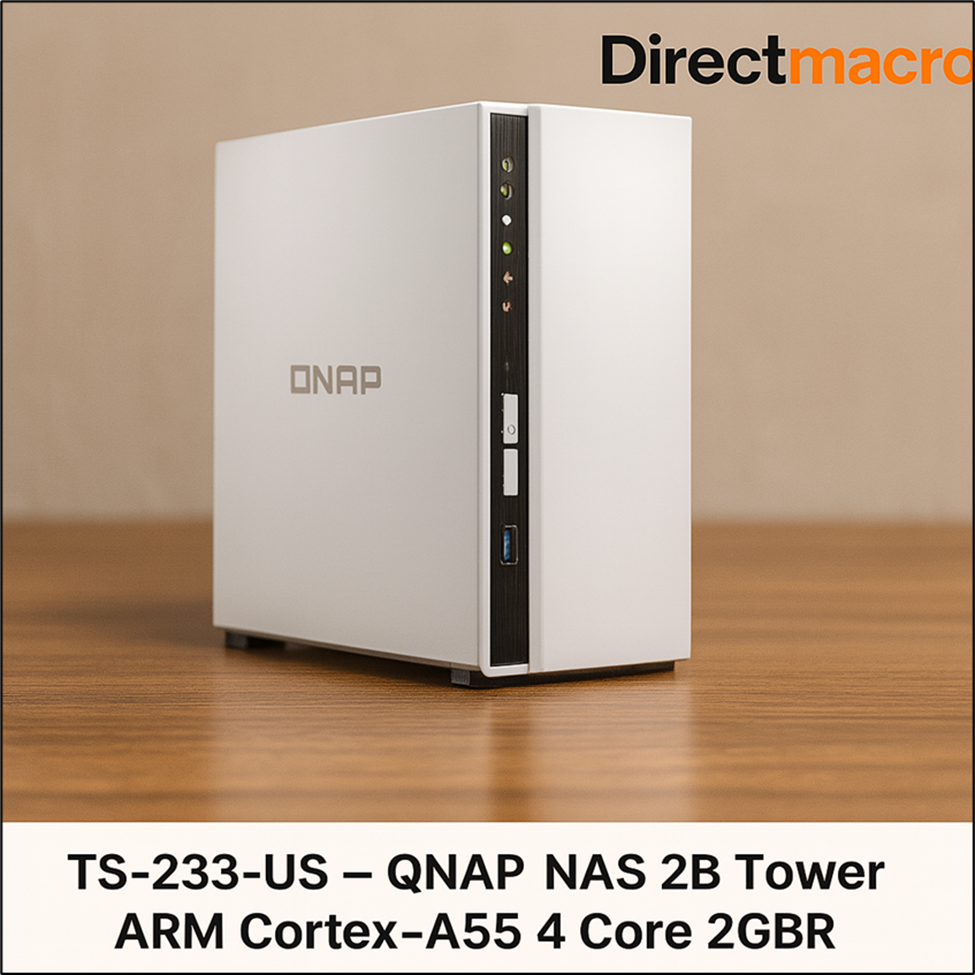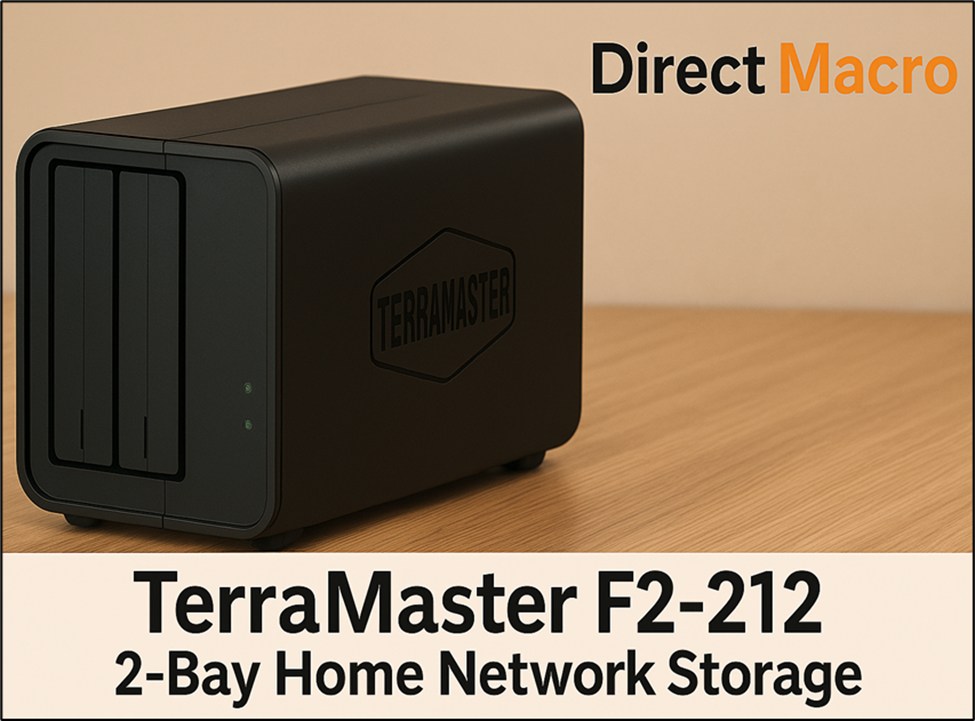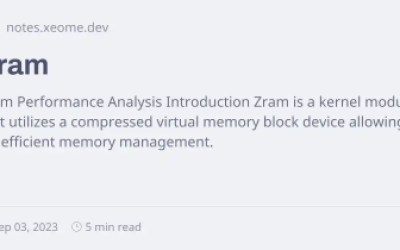Overview
A Network Attached Storage (NAS) device will be more than just a novelty for tech enthusiasts. It will be a must-have for any digital home. A NAS makes it easy to organize your massive photo collection and stream 4K movies to all of your devices. It also gives you control and peace of mind. But how do you pick the best NAS devices for home use when there are so many to choose from? This complete guide will help you find the best NAS devices for home use in 2025. It will cover everything from inexpensive entry-level models to high-end powerhouses so that you can make the right choice for your digital life.
Why You Need a Home NAS in 2025?
The online world is expanding at an unprecedented rate. Our media libraries, which include photos, videos, documents, and more, are expanding rapidly across multiple devices. Using only cloud services can be costly, and external hard drives don’t have the same level of accessibility and backup. A home NAS device fixes these problems by giving you:
- Centralized Storage: Everyone in the house can access all of your data from one accessible location.
- Easy Access: You can stream content or access files from any device with an internet connection, no matter where you are.
- Automatic Backups: Protect your important papers and memories with automatic backups from all of your devices.
- Media Streaming: Act as a dedicated server for your movies, music, and photos, sending them smoothly to smart TVs, phones, and tablets.
- Data Redundancy: RAID configurations protect against drive failure that ensuring your data remains safe even if a drive fails.
Key Considerations to Understand Your Requirements
Before examining specific models, consider how you intend to use them. It will inform you about the features and budget you need to consider.
- Primary Use: if you are looking for NAS devices for your primary use then you need to focused on is it just for storing files, streaming a lot of media, backing up essential data, or a mix of these.
- Number of Users: How many people will use the NAS regularly?
- Storage Capacity: How much data do you need to store right now, and how much do you think you’ll need in the next three to five years?
- Performance Requirements: Are you just storing documents, streaming 4K video, or running virtual machines?
- Budget: NAS devices can cost range from under $200 to over $1000 (excluding disks).
NAS Bay Count Comparison: Choosing the Right Capacity for Your Home
When selecting a Network Attached Storage (NAS) device for home use, one of the most fundamental decisions you’ll make is the number of drive bays it offers. The bay count directly impacts your potential storage capacity, data redundancy options, and ultimately, the scalability and cost of your NAS. Let’s break down the differences between 2-bay, 4-bay, 6-bay, and 8-bay NAS devices.
1. 2-Bay NAS Devices
The 2-bay NAS devices are designed for basic home storage needs. Let find out the ideal use cases, pros and cons of these devices:
- Ideal Use Cases:
- First-time NAS users: It is easy to set up and manage for people who have never used a NAS before:
- Basic file storage: It helps centralizing all of your documents, photos, and personal files in one place.
- Light media streaming: Sending a small library to a few devices without having to do a lot of transcoding.
- Personal backups: Consolidating backups from multiple computers into one location.
- Pros:
- Most Affordable: The NAS unit itself is the least expensive to purchase.
- Compact Size: Does not take up big space that making it perfect for small apartments or desks.
- Lower Power Consumption: Usually uses less energy.
- Simple RAID Options: It mainly supports RAID 0 (for speed, no redundancy) or RAID 1 (for data protection, sacrificing half of the capacity).
- Cons:
- Limited Storage Capacity: The maximum capacity is the sum of the capacities of two drives (or one drive in RAID 1).
- Limited Redundancy: RAID 1 is the only option for redundancy, and it only protects against a single drive failure.
- Less Powerful Processors: They often come with entry-level CPUs, which makes it difficult to perform tasks such as running multiple 4K transcode streams or complex apps.
- Limited Scalability: There is insufficient space to add more drives in the future.
2. 4-Bay NAS Devices
The 4-bay NAS devices are the sweet spot for many home users is providing them with a significant boost in storage space and backup options.
- Growing media libraries: Great for Plex Media Server (especially with a powerful CPU) and for keeping extensive collections of movies and TV shows.
- Comprehensive home backup: Backing up more than one family computer and device.
- Small home office/prosumers: Running more apps, light virtualization, or serving more than one user.
- Enhanced data protection: RAID 5 gives you a good balance of capacity and redundancy.
- Great Balance of Capacity and Redundancy: It supports RAID 5 (which protects against one drive failure with better capacity than RAID 1), RAID 6 (which protects against two drive failures), and RAID 10.
- Good Scalability: You can add more drives over time to increase storage space.
- More Powerful Hardware: Typically features better CPUs and more RAM, enabling it to handle more demanding tasks, such as transcoding 4K video and supporting multiple users simultaneously.
- Increased Performance: More drives can make read and write speeds faster, especially in some RAID setups.
- Higher Cost: Costs more than 2-bay units and needs more drives to start with.
- Larger Footprint: It occupies a greater amount of space.
- Increased Power Consumption: Due to more drives and often more powerful components, it consumes more power than 2-bay models.
3. 6-Bay NAS Devices
6- bay NAS devices are best for serious home users, small businesses, or content creators who require extensive storage and optimal performance.
- Large-scale media archiving: Storing huge 4K video libraries, raw photography files, or extensive music collections for a long time.
- Video surveillance (NVR): A dedicated storage device for multiple IP cameras over an extended period.
- Advanced home lab/virtualization: Using Docker containers or virtual machines to run more than one virtual machine.
- Long-term data retention: Ensuring there is sufficient space for data that will continue to grow over the years.
- Significant Storage Capacity: Can hold tens of terabytes of data.
- Superior Redundancy Options: Great for RAID 5, RAID 6, or RAID 10, which keeps your data safe.
- High Performance: Typically features processors that are more powerful and have more RAM, often with networking options such as 2.5GbE or 10GbE.
- Excellent Scalability: There is ample room for additional drives and storage space to accommodate future growth.
- Higher Price Point: Substantially more expensive than 2-bay and most 4-bay models.
- Larger Physical Size: Requires dedicated space due to its dimensions.
- Higher Power Consumption: Utilizing more drives and powerful components requires more electricity usage.
4. 8-Bay NAS Devices
The 8-bay NAS devices are the best choice for home users who need a lot of storage space, professionals who work with media, or people who are building a full home data center.
- Professional content creation: Storing and editing massive video projects (like 8K footage), big graphic design files, and audio archives right on the NAS.
- Multi-user and multi-role households: Supporting many users with different storage and application needs.
- Extensive home lab or server hosting: Running multiple demanding apps, databases, or virtual machines at the same time.
- Maximum redundancy and peace of mind: Using RAID 6 or RAID 10 across several drives.
- Massive Storage Capacity: It can hold hundreds of terabytes, which is more than enough space for almost any home use case.
- Highest Levels of Redundancy: RAID 6 or RAID 10 are the best choices because they protect against multiple drive failures better than any other type of RAID.
- Exceptional Performance: Equipped with high-end processors, ample RAM, and typically featuring 10GbE networking for optimal throughput.
- Long-Term Scalability: Provides the most room to grow in the future without requiring a new unit.
- Premium Price: This is the most expensive option by a wide margin for the unit and the drives that come with it.
- Largest Footprint: Needs its own space and often resembles a small desktop PC tower.
- Highest Power Consumption: Increased operational costs due to more drives and powerful components.
- Overkill for Most Users: The power and capacity may be much more than what an average home needs.
To ensure you buy a NAS device that perfectly balances capacity, performance, redundancy, and budget for your home in 2025, consider these differences and match your needs with the proper NAS bay configuration.
Best Budget NAS Under $250: Affordable Network-Attached Storage Devices In 2025
There are several excellent options for individuals seeking to enter the NAS world without incurring significant expenses. These options offer basic features. Most of the best budget NAS 2025 options are 2-bay setups, which strike a good balance between price and basic features. You want your basic file storage, light media streaming and home backups to work reliably.
Synology DiskStation DS223j
Often, it’s the best budget NAS under $250 (excluding disks). This NAS features 2- bays, is easy to use, runs on the simple DSM operating system, and is well-suited for most home users. Synology DiskStation DS223j is great for storing photos, sharing files and even streaming Plex (without transcoding).
QNAP TS-233

The QNAP TS-233 is an excellent choice for those on a budget, offering 2-bay design. It works well and comes with QNAP’s QTS operating system, which provides a wide range of features. It can easily handle multiple file access and backup tasks simultaneously.
Terra Master F2-212

The Terra Master F2-212 is a basic 2-bay solution for people on a very tight budget. Its software might not be as good as Synology’s or QNAP’s, but it’s a good deal for basic storage and backup needs.
These models are ideal for individuals new to NAS or those who do not require extensive storage space. They have enough power for basic firewalls and user permissions for home NAS security features.
Top Home NAS Devices: Mid-Range Performance
Mid-range NAS devices outperform low-cost models due to faster processors, more RAM, and, in many cases, more storage bays. It enables individuals to excel at difficult activities and promotes future growth. Most people look for the top home NAS devices, and these are usually the top choices.
Synology DiskStation DS723+

Flexible 2-bay NAS that does more than expected. Synology DiskStation DS723+ can boost performance with NVMe cache drives and expand capacity with a 5-bay expansion unit, which is surprisingly scalable. Its fast processor is ideal as NAS for Plex media server (4K transcoding), and virtual machines.
QNAP TS-464

It has Intel Celeron processors, dual 2.5GbE LAN ports, and M.2 SSD slots for caching. QNAP TS-464 device is recommended for a powerful NAS for home backup that supports multiple users, and streams high-bandwidth media.
AS3304T-ASUSTOR Drivestor 4 Pro

The Drivestor 4 Pro is a solid 4-bay solution featuring 2.5GbE connectivity and firm performance. ASUSTOR’s ADM OS is user-friendly and offers a wide range of applications. It’s a versatile and valuable tool for busy households.
These mid-range devices are an outstanding balance between price and features. They support more advanced home NAS security features and strong backup solutions.
High-End NAS Solutions: Uncompromised Power
High-end NAS devices are ideal for power users, small businesses and media collectors. They have more RAM, drive bays, and processing power. They also have 10GbE networking for fast speeds. Top home NAS devices perform best with these models.
- Synology DiskStation DS1522+ / DS1823xs+: Synology DiskStation DS1522+ has 5-bays and optional 10GbE and M.2 NVMe. It excels at serious media management and virtualization. Synology DiskStation DS1823xs+ is a more powerful 8-bay option with the most storage and performance. These can transcode multiple 4K files at once, them ideal heavy NAS for Plex media server setups.
- QNAP TVS-x72XT Series (e.g., TVS-672XT, TVS-872XT): These fast models have Intel Core processors, 10GbE, and Thunderbolt ports. Professional video editing, large-scale virtualization and fast data transfers are their specialties. These are great 10GbE home NAS options. The 6-bay and 8-bay options store lots of data.
- Terra Master F5-422 / F8-422: If you want high-end features without breaking the bank then Terra Master’s Fx-422 series has 10GbE connectivity on their 5-bay and 8-bay models. Their software ecosystem is smaller than Synology or QNAP, but they offer fast network speeds at a low price, making them a good choice for high-end top home NAS devices that prioritize raw bandwidth.
These devices are designed for large-scale NAS for home backup systems and professional media workflows, featuring robust home NAS security features such as advanced snapshotting and data integrity checks.
DIY NAS vs. Appliance NAS: Which Path is Right for You?
When you look for the best NAS devices for home use, you will probably come across the DIY NAS vs. appliance NAS debate. Here are the pros and cons about each and why they are best and right choice for you in 2025.
1. Appliance NAS (Synology, QNAP, etc.)
- Pros: Easy to set up, comes with a pre-installed operating system and a lot of apps, gets regular software updates, it has dedicated customer support, is small and power-efficient and has hardware and software that work well together.
- Cons: Higher initial cost (performance vs. price), less hardware flexibility and limited upgrade options (CPU and RAM sometimes).
- Best For: Most home users who want software that is easy to use, stable, and looks good.
2. DIY NAS:
- Pros: It might cost less (if you have spare parts), you can use any CPU, RAM, or motherboard, you can run any OS (Free NAS/True NAS, Un RAID, Open Media Vault), and you have full control.
- Cons: Setting up and fixing problems requires technical knowledge, it often uses more power, there is no dedicated support, the software setup is more complicated, and it takes up more space.
- Best For: Tech-savvy users, those with specific hardware requirements, users who enjoy tinkering, or those with existing spare PC parts.
DIY NAS vs. Appliance NAS

An appliance NAS from Synology or QNAP is the ideal choice for the users seeking the best NAS devices for home use. It offering the right balance of speed, features, and ease of use.
NAS for Plex Media Server and Beyond
A home NAS is often used as a NAS for Plex media server. You can use Plex to organize your movies, TV shows, music, photos and stream them to almost any device. Consider these things when picking a NAS for Plex:
- Processor (CPU): It is critical for transcoding, which entails altering the format of media files on the fly to match the device playing them. A recent Intel Celeron or ARM CPU comparable to it may be adequate for 1080p transcoding. If you need to transcode more than one stream at once, an Intel Core i3/i5 or higher processor is typically suggested for 4K transcoding.
- RAM: Having more RAM (4GB to 8GB or more) makes it easier to multitask, such as with Plex.
- Network Speed: Gigabit Ethernet is usually sufficient for streaming, but if you have an extensive home network or frequently transfer large media files, a 10GbE home NAS will provide better performance.
Beyond Plex, a NAS can also be:
- A Personal Cloud: NAS can also be more than just a Plex server. For example, it can be a personal cloud that lets you access your files from anywhere without incurring monthly fees.
- A Surveillance Station: It helps you to connect IP cameras and record footage directly to your NAS.
- A Home Automation Hub: It run Docker containers for different smart home app.
- A Backup Destination: The ultimate NAS for home backup for all your devices.
Home NAS Security Features: Keeping Your Data Safe
Data security is critical. When selecting the best NAS devices for home use, carefully consider the home NAS security features that come with them.
- User Accounts and Permissions: You can control who can access what at a very detailed level.
- Firewall: Prevents unauthorized individuals from accessing the network.
- 2-Factor Authentication (2FA): This feature enhances login security by adding an extra layer of protection.
- Encryption: This protects data by encrypting shared folders and entire volumes, even when the drives are removed.
- Ransomware Protection: Features like immutable snapshots keep your backups from being encrypted by ransomware.
- VPN Server: Access your home network and NAS securely from outside.
- Regular Software Updates: Ensures known vulnerabilities are patched.
- HTTPS/SSL: Secure connections for accessing your NAS over the web.
Conclusion: Your Perfect NAS Awaits
Picking the best NAS devices for home use in 2025 doesn’t have to be hard. You can find a device that perfectly fits your digital lifestyle by determining what you need, how much money you have, and which features are most important to you. The right NAS will centralize your data, make backups easier, and open up a world of media possibilities. You can choose a reliable best budget NAS 2025, such as the Synology DS223j, a versatile mid-range QNAP TS-464, or a high-performance 10GbE home NAS for demanding media workflows. Invest in the right solution, and you will be able to control your digital world fully. For support call us at (855) 483-7810 or visit our website more assistance.
Frequently Asked Questions (FAQs.
Q1: Do I need to buy hard drives separately for a NAS?
Yes, most NAS devices are sold “diskless,” which means you have to buy the right hard drives (HDDs) or SSDs separately.
Q2: Can I access my NAS files when I’m away from home?
Yes, for sure! Most NAS brands offer mobile apps and cloud access features that enable you to access your files securely from any location with an internet connection.
Q3: Is a 2-bay NAS enough for home use?
2-bay NAS is usually enough for basic storage and backup. If you want to stream media or have a big family, 4-bays or more is better because it has more redundancy and expansion.
Q4: What’s the main benefit of a 10GbE home NAS?
10GbE home NAS has much faster data transfer speeds, which makes it great for moving large files, working with multiple users, and editing high-bitrate media.
Q5: Is it safe to store sensitive data on a home NAS?
Yes, it is very safe if you set it up correctly, use encryption, strong passwords, and keep the home NAS security features turned on. But always do what is best.









